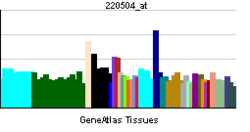Keratocan
| KERA | |||||||||||||||||
|---|---|---|---|---|---|---|---|---|---|---|---|---|---|---|---|---|---|
| Identifiers | |||||||||||||||||
| Aliases | KERA, CNA2, KTN, SLRR2B, keratocan | ||||||||||||||||
| External IDs | MGI: 1202398 HomoloGene: 5106 GeneCards: KERA | ||||||||||||||||
| |||||||||||||||||
| RNA expression pattern | |||||||||||||||||
 | |||||||||||||||||
| More reference expression data | |||||||||||||||||
| Orthologs | |||||||||||||||||
| Species | Human | Mouse | |||||||||||||||
| Entrez | |||||||||||||||||
| Ensembl | |||||||||||||||||
| UniProt | |||||||||||||||||
| RefSeq (mRNA) | |||||||||||||||||
| RefSeq (protein) | |||||||||||||||||
| Location (UCSC) | Chr 12: 91.05 – 91.06 Mb | Chr 10: 97.61 – 97.61 Mb | |||||||||||||||
| PubMed search | [1] | [2] | |||||||||||||||
| Wikidata | |||||||||||||||||
| View/Edit Human | View/Edit Mouse |
Keratocan (KTN) also known as keratan sulfate proteoglycan keratocan, is a protein that in humans is encoded by the KERA gene.[3][4][5]
Keratan sulfate proteoglycans (KSPGs) are members of the small leucine-rich proteoglycan (SLRP) family. KSPGs, particularly keratocan, lumican and mimecan, are important to the transparency of the cornea.[5]
Mutations of the gene cause cornea plana 2.
References
- ↑ "Human PubMed Reference:".
- ↑ "Mouse PubMed Reference:".
- ↑ Tasheva ES, Funderburgh JL, Funderburgh ML, Corpuz LM, Conrad GW (Jan 2000). "Structure and sequence of the gene encoding human keratocan". DNA Seq. 10 (1): 67–74. doi:10.3109/10425179909033939. PMID 10565548.
- ↑ Pellegata NS, Dieguez-Lucena JL, Joensuu T, Lau S, Montgomery KT, Krahe R, Kivela T, Kucherlapati R, Forsius H, de la Chapelle A (Jun 2000). "Mutations in KERA, encoding keratocan, cause cornea plana". Nat Genet. 25 (1): 91–5. doi:10.1038/75664. PMID 10802664.
- 1 2 "Entrez Gene: KERA keratocan".
Further reading
- Kurpakus Wheater M, Kernacki KA, Hazlett LD (1999). "Corneal cell proteins and ocular surface pathology.". Biotechnic & Histochemistry. 74 (3): 146–59. doi:10.3109/10520299909047967. PMID 10416788.
- Tahvanainen E, Forsius H, Karila E, et al. (1995). "Cornea plana congenita gene assigned to the long arm of chromosome 12 by linkage analysis.". Genomics. 26 (2): 290–3. doi:10.1016/0888-7543(95)80213-6. PMID 7601455.
- Bonaldo MF, Lennon G, Soares MB (1997). "Normalization and subtraction: two approaches to facilitate gene discovery.". Genome Res. 6 (9): 791–806. doi:10.1101/gr.6.9.791. PMID 8889548.
- Tasheva ES, Pettenati M, Von Kap-Her C, Conrad GW (2000). "Assignment of keratocan gene (KERA) to human chromosome band 12q22 by in situ hybridization.". Cytogenet. Cell Genet. 88 (3-4): 244–5. doi:10.1159/000015528. PMID 10828599.
- Tasheva ES, Conrad AH, Conrad GW (2000). "Identification and characterization of conserved cis-regulatory elements in the human keratocan gene promoter.". Biochim. Biophys. Acta. 1492 (2-3): 452–9. doi:10.1016/s0167-4781(00)00129-9. PMID 10899581.
- Wentz-Hunter K, Cheng EL, Ueda J, et al. (2002). "Keratocan expression is increased in the stroma of keratoconus corneas.". Mol. Med. 7 (7): 470–7. PMC 1950054
 . PMID 11683372.
. PMID 11683372. - Lehmann OJ, El-ashry MF, Ebenezer ND, et al. (2002). "A novel keratocan mutation causing autosomal recessive cornea plana.". Invest. Ophthalmol. Vis. Sci. 42 (13): 3118–22. PMID 11726611.
- Strausberg RL, Feingold EA, Grouse LH, et al. (2003). "Generation and initial analysis of more than 15,000 full-length human and mouse cDNA sequences.". Proc. Natl. Acad. Sci. U.S.A. 99 (26): 16899–903. doi:10.1073/pnas.242603899. PMC 139241
 . PMID 12477932.
. PMID 12477932. - Khan A, Al-Saif A, Kambouris M (2004). "A novel KERA mutation associated with autosomal recessive cornea plana.". Ophthalmic Genet. 25 (2): 147–52. doi:10.1080/13816810490514397. PMID 15370545.
- Gerhard DS, Wagner L, Feingold EA, et al. (2004). "The status, quality, and expansion of the NIH full-length cDNA project: the Mammalian Gene Collection (MGC).". Genome Res. 14 (10B): 2121–7. doi:10.1101/gr.2596504. PMC 528928
 . PMID 15489334.
. PMID 15489334. - Ebenezer ND, Patel CB, Hariprasad SM, et al. (2005). "Clinical and molecular characterization of a family with autosomal recessive cornea plana.". Arch. Ophthalmol. 123 (9): 1248–53. doi:10.1001/archopht.123.9.1248. PMID 16157807.
- Liu T, Qian WJ, Gritsenko MA, et al. (2006). "Human plasma N-glycoproteome analysis by immunoaffinity subtraction, hydrazide chemistry, and mass spectrometry.". J. Proteome Res. 4 (6): 2070–80. doi:10.1021/pr0502065. PMC 1850943
 . PMID 16335952.
. PMID 16335952. - Szabó V, Balogh K, Süveges I, et al. (2006). "The role of lumican and keratocan genes in persistent subepithelial corneal haze following excimer laser photorefractive keratectomy.". Mol. Vis. 12: 597–605. PMID 16760896.
- Khan AO, Aldahmesh M, Meyer B (2006). "Recessive cornea plana in the Kingdom of Saudi Arabia.". Ophthalmology. 113 (10): 1773–8. doi:10.1016/j.ophtha.2006.04.026. PMID 17011957.
- Aldave AJ, Sonmez B, Bourla N, et al. (2007). "Autosomal dominant cornea plana is not associated with pathogenic mutations in DCN, DSPG3, FOXC1, KERA, LUM, or PITX2.". Ophthalmic Genet. 28 (2): 57–67. doi:10.1080/13816810701351321. PMID 17558846.
- Liskova P, Hysi PG, Williams D, et al. (2007). "Study of p.N247S KERA mutation in a British family with cornea plana.". Mol. Vis. 13: 1339–47. PMID 17679937.
This article is issued from Wikipedia - version of the 6/29/2016. The text is available under the Creative Commons Attribution/Share Alike but additional terms may apply for the media files.